Soltek QBIC 3901A-300P
Overview
Soltek has been making computer products for nearly a decade now, and while they started like most companies with motherboards, they have since branched out into the graphics card and small form factor markets. The Soltek QBIC EQ3901-300P has been out for almost as long as the SN95G5. It is currently available in several variations, the only difference being the external appearance. We're looking at the brushed aluminum model (the EQ3901A). The EQ3901M has a mirrored front panel while the Mania series goes for more eye-catching colors like yellow and red.Aesthetics
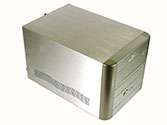 |
 |
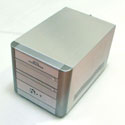 |
| Click on images to enlarge. | ||
The exterior of the QBIC is pretty typical of a SFF design. We personally prefer the brushed aluminum finish, but others might like the "bling" of the Mania models. This one is relatively subdued in appearance and would fit in with a more conservative décor. The front panel is composed of plastic, but Soltek has chosen to cover most of it with thin aluminum sheets to match the rest of the case. There isn't a whole lot in the way of front panel lighting, as the only sources are the power button and the HDD activity LEDs. The buttons provide chrome accents, and a Soltek badge takes up advertising space on the top 5.25" door.
Overall, we like the looks. In fact, we've seen the models with a mirrored finish as well as the Mania series, and the unadorned aluminum is our favorite of the Soltek offerings. Some people may prefer the more conspicuous designs, of course, and if you like what we have to say about the remainder of the EQ3901A, get whichever one you like most.
Features
|
Soltek EQ3901A-300P
|
||
| Dimension | (w)215 mm x (h)200 mm x (d)340 mm | |
| CPU Support | AMD Socket 939 up to FX-57/X2 4800+ | |
| Memory Support | PC1600/PC2100/PC2700/PC3200 up to 2GB; 2 DIMM slots | |
| Motherboard | SL-B9D-FGR (proprietary) VIA K8T800 Pro 1X-5X (200-1000MHz) HyperTransport 8-bit/8-bit to 16-bit/16-bit HT Width |
|
| Expansion Slots | 1 x AGP 8X; 1 x PCI | |
| Power Supply | 300W APFC Power Supply 5 x 4-pin Molex; 2 x 4-pin FDD; 1 x SATA 1 x 4-pin ATX12V; 1 x 20-pin ATX |
|
| Internal Connections | 2 x SATA; 2 x IDE; 1 x FDD; 1 x LPT | |
| Audio | Realtek ALC850 7.1 channel | |
| LAN | 1 x 10/100/1000 Mbps | |
| Drive Bays | 1 x 3.5 External 1 x 3.5 Internal (HDD) 2 x 5.25 External (CD/DVD) |
|
| Front I/O | 2 x USB 2.0 1 x IEEE1394 (6pin) MIC, Head-phone, S/PDIF Optical Out Power & Reset buttons Power on & HDD LED indicators |
|
| Rear I/O | 4 x USB 2.0 1 x IEEE1394 (6pin) PS/2 KB, PS/2 Mouse 2 x COM (Serial) ports RJ-45 LAN Port (10/100/1000Mbps) Line-in, Center/Sub, L/R Front, L/R Side, L/R Rear |
|
| Overclocking | CPU 200-250; CPU Ratio 4X-Max; Vcc 0.800-1.700V; DDR Auto, 2.65-2.95V; AGP 1.5-1.8V |
|
| Extras | IcyQ cooling | |
| Full Image Set | Soltek EQ3901A-300P Pictures (3.8MB) | |
| Manufacturer Link | Soltek EQ3901-300Pro | |
Like all of the other units in this roundup, the standard features are all present. Firewire, USB, GbE, and audio are included, as well as IDE and SATA support. Somewhat unique is that this is the only 939 SFF to use a VIA chipset, the K8T800 Pro with the VT8237 South Bridge. Due to the integrated memory controller in the Athlon 64, we don't expect to see any major variations in performance, but we do feel that the NVIDIA chipsets are still the more robust options. Overclocking and memory support simply tend to be a bit better with the nForce chipsets. That caveat aside, the Soltek is still a reasonable option. Let's take a closer look at the specifics.
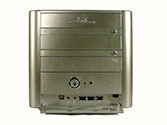 |
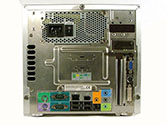 |
| Click on images to enlarge. | |
We've mentioned the pros and cons of AGP vs. PCIe graphics in numerous articles, and our basic feeling is that AGP systems remain attractive for upgraders, but we wouldn't recommend spending a lot of money on a new system without moving to PCIe. Looking at the price of the Soltek 3901 (around $250 if you can find it), though, you could actually get a moderate graphics card and the case for less than many other SFF setups. The long term prospects for AGP aren't very good - new cards may lag a few months behind their PCIe counterparts, and the cost (due to the use of bridge chips) may be slightly higher; worse is that NVIDIA has so far made no move to provide a 7800 card with AGP support.
The real questions then are how long you plan to keep your system and how far you want to upgrade it. With the new Athlon 64 X2 chips now available, a socket 939 system has the potential to last several years. AGP may be more of a hindrance over such a lengthy period of time, but it's difficult to estimate the rate of transition from AGP, given the huge installed base of systems. It's hard to imagine NVIDIA and ATI totally abandoning AGP users and forcing them to upgrade motherboards, but NVIDIA at least isn't going out of their way to support AGP with the G70 - yet. Marketing loves to talk about the bandwidth advantage that PCIe has over AGP, but so far, it's mostly a theoretical advantage.
The power supply in the Soltek is of reasonable size to run a fully loaded system, as it is a 300W model. With the potential to have as many as three hard drives if you use the floppy bay and one of the 5.25" bays, the amount of power could prove useful. We wouldn't recommend loading the system with the fastest - and often hottest - hard drives that you can find, but several 7200 RPM drives should work well. Power and data cables are also pre-installed and routed to aid the installation process, with both the SATA and molex power cables available for the hard drive bay. With five 4-pin molex connectors, two 4-pin floppy connectors, and an SATA power connector, the power supply also has plenty of connection available without worrying about getting cable splitters. That does have the drawback of creating cable clutter if you go with a minimal configuration of a single HDD and DVDR, but the larger size of the 3901 makes the cables manageable.
Closing up with the audio solution, Soltek has chosen a Realtek 8 channel setup, including ample connections for running 7.1 along with a microphone/line-in connection. S/PDIF optical out is also available, although the port is located on the front of the PC, which isn't our preferred location. The lack of S/PDIF IN may be a problem for some people, and if so, you will either want a different SFF, or you can purchase a card like the Turtle Beach Catalina 8. As for the quality of the audio, the front headphone port was once again guilty of having noticeable static. The rear ports were fine, and the static on the front port wasn't as bad as that on the ST20G5, but users interested in using headphones will be disappointed. The audio was also standard AC'97 audio rather than HD audio, although as we saw with the ST20G5, having HD audio doesn't necessarily mean it will sound better.
One final perk of the Soltek is a tchotchke: you get a carrying case/backpack with the 3901 (as well as many of Soltek's other SFFs). Is it incredibly useful? Probably not, but it is a nice freebie. The backpack could be used either for carrying the case or for more mundane purposes like toting around textbooks. The black and orange color scheme is certain to stand out in the crowd, and some may feel that the bag as a whole is too big for normal use. Worst case scenario, though, is that it's still a convenient transportation device for the computer. We used it to tote the system around a few times, and it works well enough. It isn't a snug fit around the case, and we wouldn't recommend running or any other similar activity with a computer case strapped to your back, but LAN Party attendees will find it convenient to carry the case and some accessories on their back so that their hands are free to carry other computer parts - it's one less trip to the car.



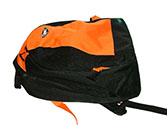








29 Comments
View All Comments
JarredWalton - Friday, August 12, 2005 - link
I'll hit the KLOSS as soon as I can. (I have it already.) So unless someone else votes, I guess I'll get the KLOSS reviewed next.Sokolum - Thursday, August 11, 2005 - link
For the last 2 months now i have a ST20G5 using as a MCE system. There are a few problems what i have encounbtered, one of them is that the system behaviour changes when i change a setting within the BIOS. Those aren't dramatic changes. But with every change, it looks like that the graphics runs muchmore slower, you can see this with dragging a windows screen over your desktop, you get trails from that window...The system only runs smooth when i *don't* touch those setting. Happily the things keep running smoothly when i enlarge the shared video memory.
For the MCE side, i failed to make the Hauppauge 500MCE run compleetly as it should, i am only able to run TV 'Tunner 1' without problems when i *disable* TV 'Tunner 2' within windows Device Manager. Shuttle or Hauppauge couldn't help me with this case.
As the review documented, this is one of the cases that RAID is causing the problem in this story. In my MCE setup, i don't use RAID (there is *no* room for a seccond drive when you installed a floppy drive). Why RAID is the problem, what i have been told is that RAID wants to use al of the PCI bandwith. It seems the nature of RAID in this kind of systems, just een told, i am not for 100% sure, but it seems plausible to mee.
, a nice looking machine. I solved the problem for the flash cards with buying a floppy disk what come with a integrated card readed, see link:
http://www.alternate.nl/html/shop/productDetails.h...">http://www.alternate.nl/html/shop/productDetails.h...
mino - Thursday, August 11, 2005 - link
Jared I must confes, this is the _first_ time i see everclocking test done as it should have been. I really appreciate the comments for newbies (it makes easier to me to explain to them if you could reference somthing :). Also finally use of correct term oo A64 base freq./FSB issue. I think this way is it should be done for _all_ A64 motherboard review.1) do a maximum base freq. check (by keeping memfreq. around DDR400 + CPU not overclocked
2) do a max memclock test at 1T (with some proven components, just to check quality of CPU to MEM routing on the MB)
3) do some max. overclock test (actually this may be optional since it depend mostly CPU chosen)
Keep at this route and many readers may finaly undestand the basics of A64's OCing.
JarredWalton - Thursday, August 11, 2005 - link
I'm working on some detailed overclocking articles right now. Glad you enjoyed the section, and I'll be going into a LOT more detail (with benchmarks) on some future OC articles.dropadrop - Thursday, August 11, 2005 - link
Thanks for the nice review,If you are considering a followup I would love to see you test usb. While the usb on my sn95g5 v2 works for casual things like a mouse, digital camera and memory card reader, it does not work for an ipod shuffle, external soundcard (hercules dj console), or external hardisk.
There have been alot of people with similar experiences. It wold be great if you could find a way to test the sff's with a few "demanding" usb devices, and even measure the voltage (and stability of it) supplied via usb.
I also second the request for you to test the sn95g5 with an X2. The new bios surely supports them, as people in north america have been getting their current rigs modded by shuttle for support. I would love to see how your's supports it (and maby even venice / san diego) without being modded. I believe you would have the chance to help alot of confused SN95G5 users by trying out a few cpu's in it.
JarredWalton - Thursday, August 11, 2005 - link
I will definitely give it a shot. At present, my intention is to purchase an external IDE HDD enclosure with USB2.0 and 1394A support and do some file transfers and such between that and the system. The problem with that approach is that the enclosures all have an external power source. Can anyone recommend an inexpensive USB/Firewire HDD enclosure that gets the power over the USB port? http://www.newegg.com/Product/Product.asp?Item=N82...">I found this one, but I'm not really keen on spending $160 for something I don't personally need.dev0lution - Wednesday, August 10, 2005 - link
How come the SN25P details don't mention the update from nforce4 standard to nForce4 Ultra? I'm thinking of getting one so I went to the previous review and it lists chipset in the specs as the nForce 4 standard, but if you go to Shuttle's current product page for the SN25P it lists the chipset as the Nforce4 Ultra. Who's correct?JarredWalton - Thursday, August 11, 2005 - link
I think I may have just been lazy or neglectful in the original SN25P article. I'm pretty sure it was always nForce4 Ultra. Then again, regular nf4 vs. nF4U only adds SATA-II support IIRC. I don't see anything about SN25P supporting SATA-II which is sort of odd.Cookie Crusher - Wednesday, August 10, 2005 - link
I know it may be a "dated" or more "Entry Oriented" socket, but I have found that the socket 754 SFF systems are great for gaming and general use. Was there ever a roundup for them? If not, I'd like to see maybe a limited look at them to remind everyone that they are viable alternatives to, and about $75-$100+ cheaper than, these socket 939 options.I think it's important to point this out because of the note in the article that a SFF option incurs a premium....maybe so, but there are still cost effective options in that market. thanks.
Cookie Crusher - Wednesday, August 10, 2005 - link
Nevermind.....i found the roundup I was hoping for.....still, would be nice to make that reference to the older socket types as legitimate choices for SFF hopefuls on a budget. :-)